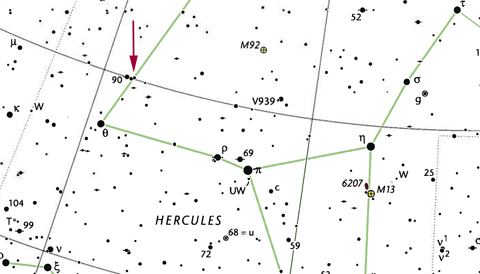Magnitude 6.55 Apparent magnitude (V) 6.55 | ||
 | ||
People also search for Epsilon Herculis, Kappa Herculis | ||
HD 162826 (HR 6669) is a star located in the constellation of Hercules and is located about 110 light-years (34 parsecs) from Earth. With an apparent magnitude of 6.46, the star can be found with binoculars or a low-power telescope by reference to nearby Vega in the constellation Lyra. It is 15% more massive than the Sun, with a slightly hotter surface temperature. It has no known planets; the current state of knowledge excludes "hot Jupiters" and suggests that a more distant Jupiter is unlikely, but terrestrial planets are possible. The star's spectra had been under observation previously.
Contents
The star is considered to be a stellar sibling of the Sun. Solar siblings are those stars that formed from the same gas cloud and in the same star cluster; the term was introduced in 2009. The Sun is a G2V star with a temperature of 5778 K and is 4.6 billion years old.
Originating cluster
In May 2014 astronomers at the University of Texas at Austin announced that HD 162826 is "almost certainly" one of what may be thousands of "siblings" of the Sun, emerging from the same stellar nursery some 4.5 billion years ago. This conclusion was reached by determining it has the same chemical composition as the Sun, including rare elements such as barium and yttrium, and by determining its orbit and projecting backward its revolutions about the galactic center. The discovery of a first solar sibling by searching for specific rare elements may make it easier to identify other siblings in the future. However, HD 162826 is probably the nearest solar sibling of this type, because others would have been identified first if they had been closer to the Sun. It had not been expected that even one sibling would be found at this relatively short distance; the study that identified this star worked on a dataset of only 100,000 stars, in preparation for data about billions of stars expected from the Gaia Space Telescope in five to ten years.
Lead researcher Ivan Ramirez explained the significance of finding solar siblings in a press release for the University of Texas at which he works. "We want to know where we were born. If we can figure out in what part of the galaxy the Sun formed, we can constrain conditions on the early solar system. That could help us understand why we are here." He also said there was a "small, but not zero" chance that planets with life might orbit solar sibling stars, because during the frequent collisions during planetary formation material might have travelled from one system to another. He said the siblings might be "key candidates" in the search for extraterrestrial life. A scenario for transfer of life by this means might require life or a precursor molecule to be shielded from radiation for millions of years, dormant within an outgoing chunk of planetary debris one meter or more in diameter that is produced by a meteorite impact, until this new meteorite impacts on a different planet. Such an unlikely event might have transferred life from another planet to Earth or vice versa.
The cluster in which HD 162826 and the Sun formed is believed to have been an open cluster, permitting the stars to scatter widely over time. The stars in this cluster were not too closely packed during their formation to disrupt planetary disk development, but were not so far apart as to prevent the seeding of Earth with radioactive elements produced by a nearby supernova.
Sun comparison
This chart compares the sun to HD 162826.
